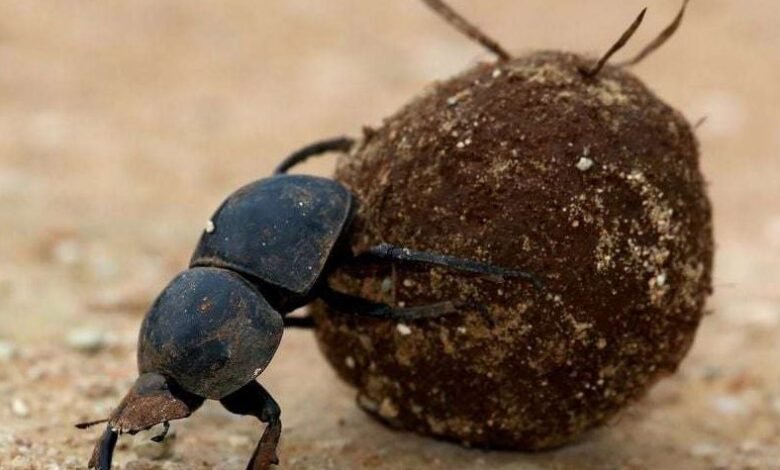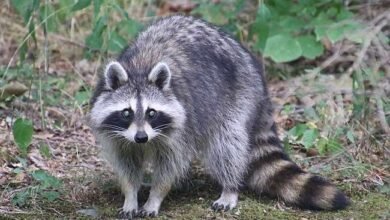Dung Beetles: Rollers, Tunnellers, and Dwellers


 Greek mythology holds that Zeus punished the murderous tyrant-king Sisyphus by banishing him to Tartarus for eternity, where he has to roll a big rock up a hill, only to have it tumble back down as he nears the top. Big deal – he got off easy.
Greek mythology holds that Zeus punished the murderous tyrant-king Sisyphus by banishing him to Tartarus for eternity, where he has to roll a big rock up a hill, only to have it tumble back down as he nears the top. Big deal – he got off easy.
Zeus could have condemned him to push a towering sphere of solid excrement that weighed ten times more than he did, walking backwards the whole time, and then dig a hole, bury the thing, and return to where he started to repeat the process.
It would’ve been worse yet if old Sisyphus was obliged to pack each colossal poop-orb into shape, mucking poo from an interminable pile. With his bare hands, no less – and it’s not like the underworld’s torture-vault likely has a place to wash off at the end of the day.
While it sounds like a punishment dreamed up by a sadist, it’s an actual job description, except that it takes place daily here on Planet Earth, not in a mythological dungeon.
It’s lucky for us that there are many who eagerly take on this Herculean task as their life’s calling, because things would be a lot harder for humans without them. They’re like a tireless army of Oompa-Loompas, except without the racist overtones, and using a different kind of fudge.
If not for these workers, our grocery bills would be even higher than they are now, and our world would be hotter than it already is. Plus, we’d miss out on their endlessly entertaining YouTube videos.
There are about 5,700 species of coprophagous, or manure-munching, beetles in the family Scarabaeidae. Aptly called dung beetles, they are the strongest creatures in the world relative to their size. Dung beetles can be found in most natural environments around the world outside of Polar regions.
While their lifestyle is admittedly less than glamorous, they add tens of billions of dollars to our economy each year. They do this in the form of ecosystem services like water-quality protection, reduced pest populations, and increased crop yields, among other things.
By quickly burying livestock feces in pastures and on rangeland, dung beetles conserve nitrogen and aerate the root zone, boosting soil fertility. They also help control diseases and parasites of livestock, in some cases reducing parasites by as much as 90 percent.
This saves U.S. farmers an estimated $380 million annually. Just imagine if we had to cover these costs at the grocery store.
Dung beetles also reduce greenhouse-gas emissions by as much as 12 percent in pastures. This is because breaking up larger fecal deposits into balls of dung short-circuits the production of methane, a greenhouse gas that’s 28 times more potent than carbon dioxide at warming the planet.
Although dung beetles are pervasive, they’re surprisingly fragile. Dung beetles can be harmed by pesticide residues and cattle dewormer, for example. Some farmers are motivated to adopt organic practices to safeguard dung beetles’ benefits to their farm operations.
In a way, we are rediscovering the importance of dung beetles, something the ancient Egyptians knew very well. Dung beetles were revered by Egyptians, who saw the dung-ball as representing the cycle of life, and dung beetles feature prominently in early sculpture and other art forms.
I’m not sure how long the Japanese have been enamoured with dung beetles, which caught the eye of the creators of a popular Japanese media franchise.
A dung-beetle-inspired Pokémon character called Rellor uses psychic energy, not its feet, to make its earthen “dung” ball. As fun as it is to watch dung beetles roll comically large balls of crap around, not all of them do this.
Scientists have classified dung beetles into three general types: rollers, tunnellers, and dwellers, although I like to imagine there’s a sub-sect of borrowers who join in as well – perhaps Arrietty and her friends borrow a few dung balls now and then for bean-bag chairs or whatever.
Like rollers, tunnellers also fashion poop-spheres, which they bury in branched tunnels directly under or adjacent to a mother-lode of dung. Dwellers, as their name suggests, make themselves at home inside a cow pie (or elephant, bison, bear, etc.-pie), competing with rollers and tunnellers for the precious resource, and helping to break it down faster.
Rollers, able to bury 250 times their weight in crap each night, have an incentive to work hard that Sisyphus lacks: they get to make bug-love after a long night of poop-boulder budging.
Generally, a pair of dung beetles work together to form the sphere, but the male usually does the pushing. Of the ball, I mean. Once the last crap-globe is rolled away and buried, the two beetles mate underground. Afterwards, the female lays her eggs in the poo-ball, which will nourish her babies.
If you think dung beetles have a disgusting hobby, you should meet their corpse-loving cousins, the carrion beetles. More specialized and far less numerous, these colorful beetles play pat-a-cake with dead stuff, burying sticky balls of putrefaction before they mate and lay eggs in the high-protein goo. I have actually seen these guys at work on a dead bird years ago. At the time, I didn’t realize it was an uncommon event.
As distasteful as their fetish sounds, it is another essential service that helps keep flies and diseases to a minimum. Unfortunately, habitat loss due to development, as well as light pollution from artificial lighting at night, are taking a toll on carrion beetle populations.
Fittingly, there is a genus of dung beetle named Sisyphus, encompassing about 90 species. Even though every day is a crappy day for those dung beetles, at least their endeavours, unlike those of the legendary Sisyphus, make the world a better place.
Thanks to Michel-André Vallières of Wakefield, Québec for suggesting this topic.
Source link




